SLVSC85C August 2013 – May 2015 TPS65279
PRODUCTION DATA.
- 1 Features
- 2 Applications
- 3 Description
- 4 Revision History
- 5 Description (continued)
- 6 Pin Configuration and Functions
- 7 Specifications
-
8 Detailed Description
- 8.1 Overview
- 8.2 Functional Block Diagram
- 8.3
Feature Description
- 8.3.1 Enable and Adjusting Undervoltage Lockout (UVLO)
- 8.3.2 Adjustable Switching Frequency and Synchronization
- 8.3.3 Soft-Start Time
- 8.3.4 Out-of-Phase Operation
- 8.3.5 Output Overvoltage Protection (OVP)
- 8.3.6 Bootstrap Voltage (BOOT) and Low Dropout Operation
- 8.3.7 Overcurrent Protection
- 8.3.8 Current Sharing Operation
- 8.3.9 Thermal Shutdown
- 8.4 Device Functional Modes
- 9 Application and Implementation
- 10Power Supply Recommendations
- 11Layout
- 12Device and Documentation Support
- 13Mechanical, Packaging, and Orderable Information
Package Options
Mechanical Data (Package|Pins)
Thermal pad, mechanical data (Package|Pins)
Orderable Information
7 Specifications
7.1 Absolute Maximum Ratings
over operating free-air temperature range (unless otherwise noted)(1)| MIN | MAX | UNIT | |||
|---|---|---|---|---|---|
| Voltage at VIN, PVIN1, PVIN2 | –0.3 | 20 | V | ||
| Voltage at LX1, LX2 (maximum withstand voltage transient < 20 ns) | –4.5 | 23 | V | ||
| Voltage at BST1, BST2, referenced to LX1, LX2 pin | –0.3 | 7 | V | ||
| Voltage at V7V, EN1, EN2, RLIM1, RLIM2, PGOOD1, PGOOD2, MODE, ISHARE, ROSC | –0.3 | 7 | V | ||
| Voltage at SS1, SS2, FB1, FB2, COMP1, COMP2 | –0.3 | 3.6 | V | ||
| Voltage at AGND, PGND1, PGND2 | –0.3 | 0.3 | V | ||
| TJ | Operating virtual junction temperature | –40 | 150 | °C | |
| Tstg | Storage temperature | –55 | 150 | °C | |
(1) Stresses beyond those listed under Absolute Maximum Ratings may cause permanent damage to the device. These are stress ratings only, and functional operation of the device at these or any other conditions beyond those indicated under Recommended Operating Conditions is not implied. Exposure to absolute-maximum-rated conditions for extended periods may affect device reliability.
7.2 ESD Ratings
| VALUE | UNIT | ||||
|---|---|---|---|---|---|
| V(ESD) | Electrostatic discharge | Human body model (HBM) | 2000 | V | |
| Charge device model (CDM) | 1000 | ||||
7.3 Recommended Operating Conditions
over operating free-air temperature range (unless otherwise noted)| MIN | MAX | UNIT | ||
|---|---|---|---|---|
| VIN | Supply input voltage range | 4.5 | 18 | V |
| IOUT1, IOUT2 |
Load current | 0 | 5 | A |
| Vout | Output voltage | 0.6 | 9 | V |
| EN | Enable voltage | 0 | 6 | V |
| TJ | Operating junction temperature | –40 | 125 | °C |
7.4 Thermal Information
| THERMAL METRIC(1) | TPS65279 | UNIT | ||
|---|---|---|---|---|
| DAP (HTSSOP) | RHH (VQFN) | |||
| 32 PINS | 36 PINS | |||
| RθJA | Junction-to-ambient thermal resistance | 35 | 30.8 | °C/W |
| RθJC(top) | Junction-to-case (top) thermal resistance | 17.7 | 18.8 | °C/W |
| RθJB | Junction-to-board thermal resistance | 19 | 6 | °C/W |
| ψJT | Junction-to-top characterization parameter | 0.5 | 0.2 | °C/W |
| ψJB | Junction-to-board characterization parameter | 18.9 | 6 | °C/W |
| RθJC(bot) | Junction-to-case (bottom) thermal resistance | 1.3 | 0.7 | °C/W |
(1) For more information about traditional and new thermal metrics, see the Semiconductor and IC Package Thermal Metrics application report, SPRA953.
7.5 Electrical Characteristics
TJ = –40°C to 125°C, VIN = 12 V (unless otherwise noted)7.6 Typical Characteristics
TA = 25°C, VIN = 12 V, ƒSW = 625 kHz (unless otherwise noted)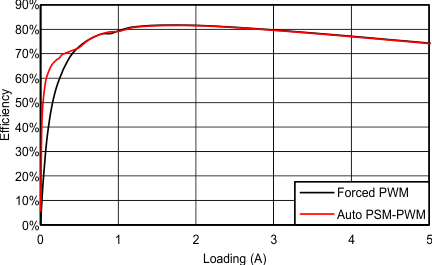
VIN = 12 V, VOUT = 0.8 V
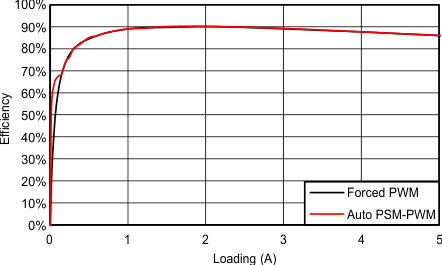
VIN = 12 V, VOUT = 1.8 V
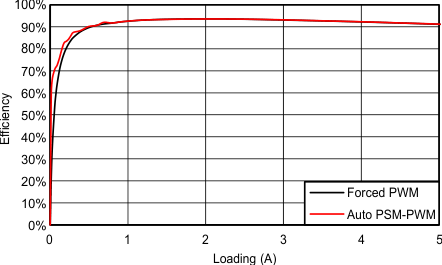
VIN = 12 V, VOUT = 3.3 V

VIN = 12 V, VOUT = 5 V
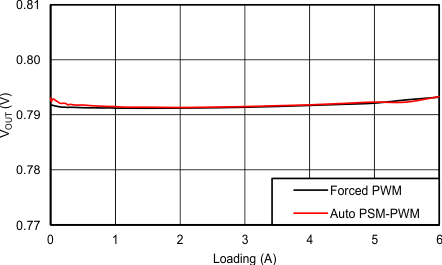
VIN = 12 V, VOUT = 0.8 V
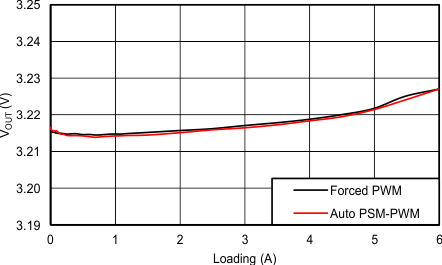
VIN = 12 V, VOUT = 3.3 V
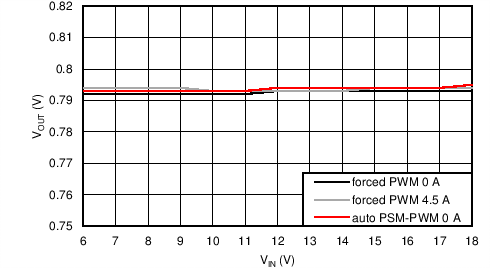
VOUT = 0.8 V
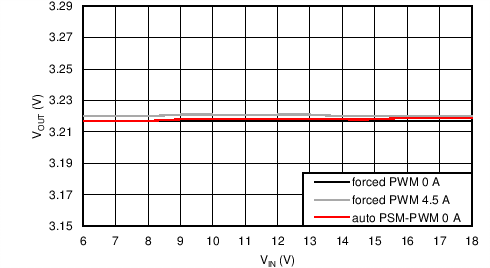
VOUT = 3.3 V
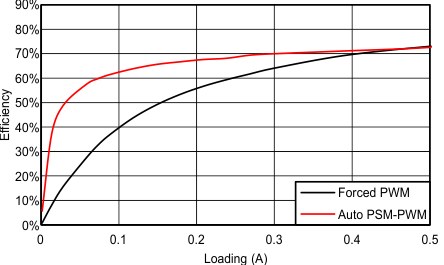
VIN = 12 V, VOUT = 0.8 V
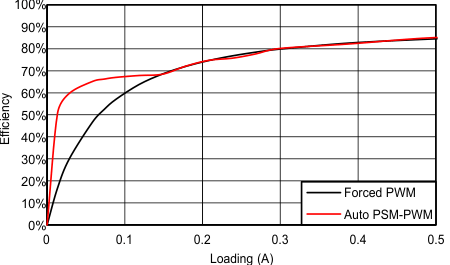
VIN = 12 V, VOUT = 1.8 V
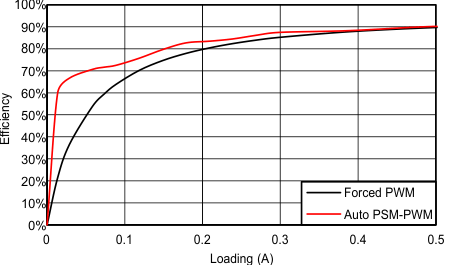
VIN = 12 V, VOUT = 3.3 V
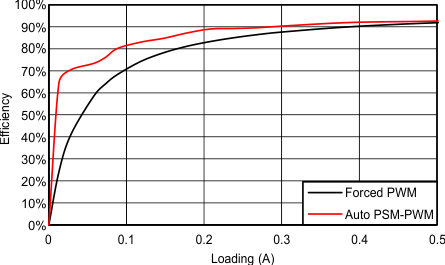
VIN = 12 V, VOUT = 5 V
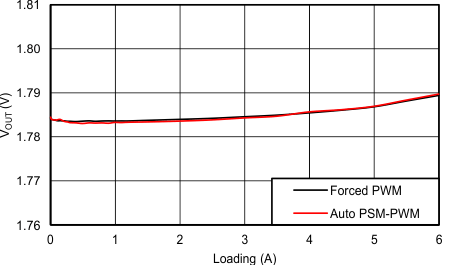
VIN = 12 V, VOUT = 1.8 V

VIN = 12 V, VOUT = 5 V
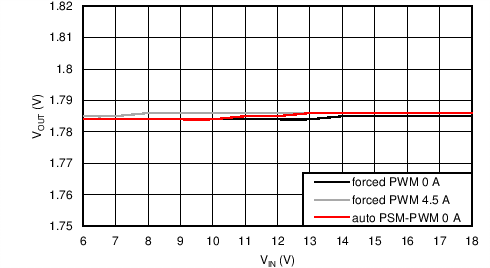
VOUT = 1.8 V
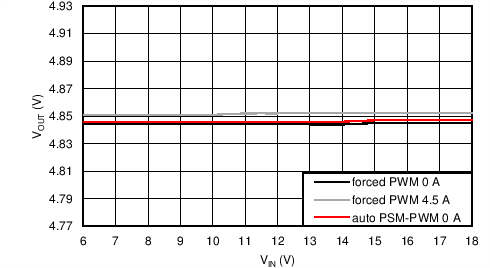
VOUT = 5 V